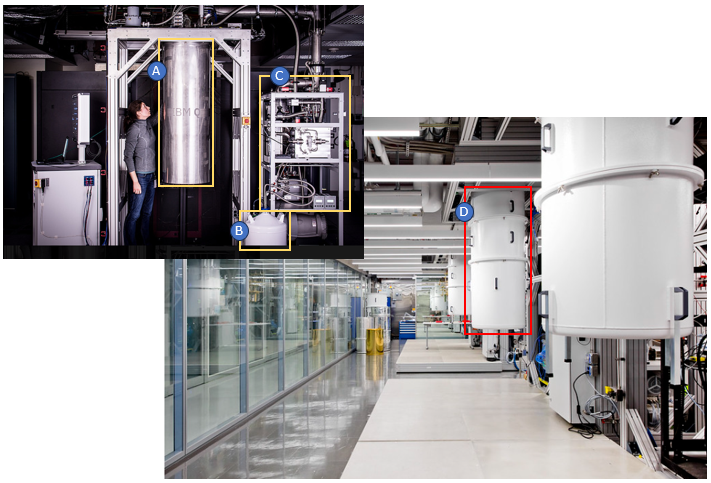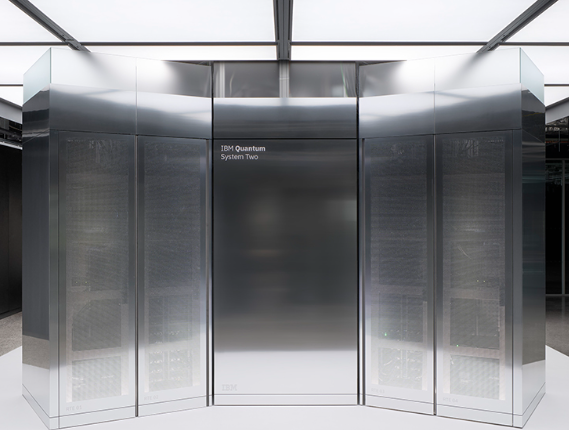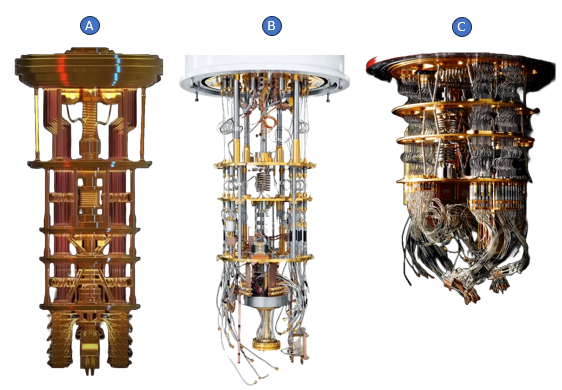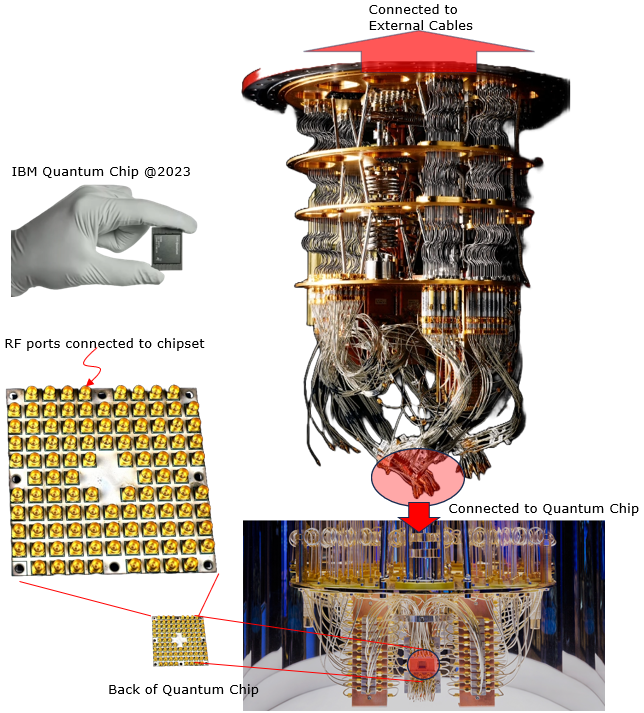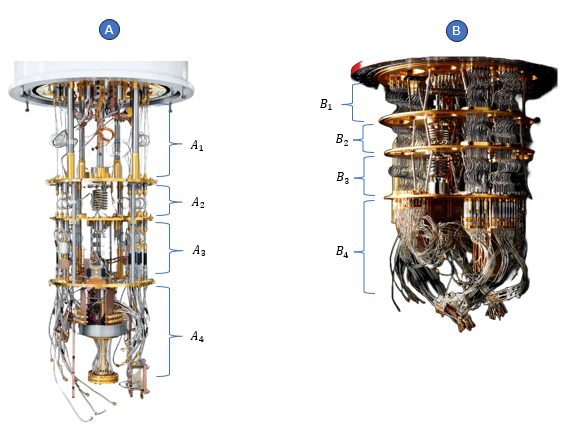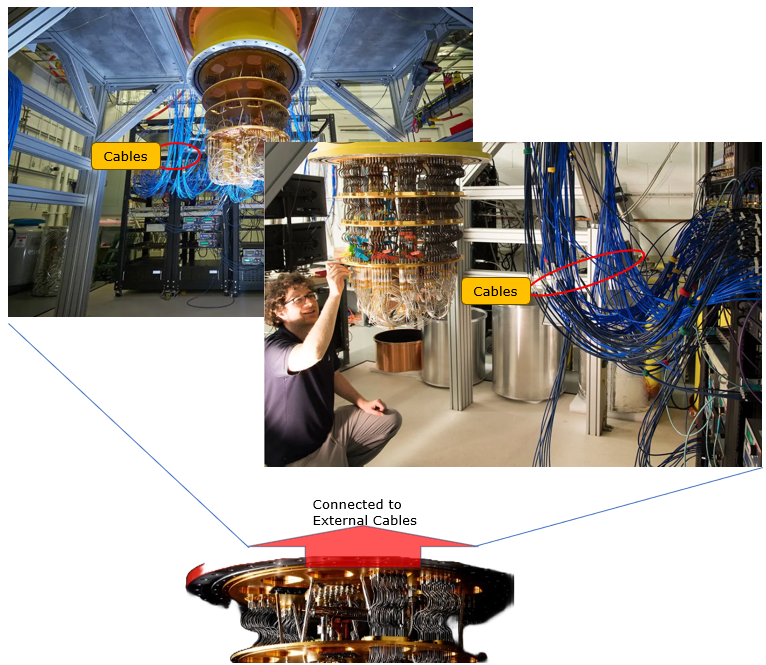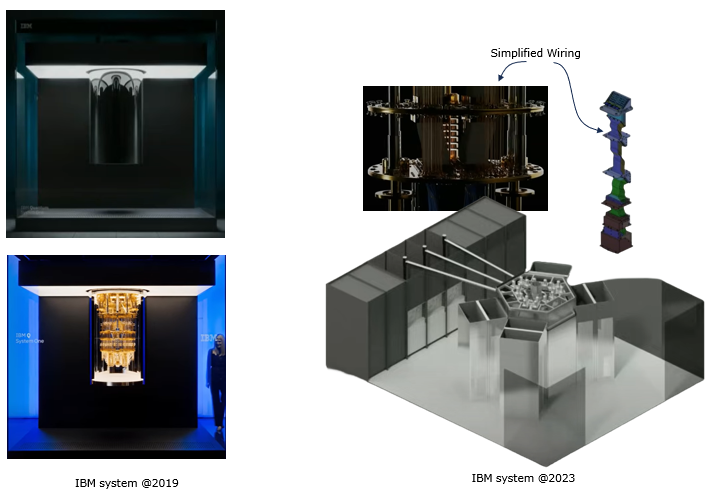|
|
|||||||||||||||||||||||
|
Hardware Structure of Quantum ComputerQuantum computers aren't just the stuff of theory any more - they're real, and they're spectacular. In these notes, we're going on a journey to demystify the sophisticated hardware that powers these incredible machines. Quamtum computers are real and we have real working hardwares from various companies. In this note, I will try to go through overall pictures of Quamtum computer hardware which are commonly available now.
Before You ReadRecently I found a good introduction video for Quantum Computer Hardware from IBM. I think it would be helpful for you to watch that video first before you start reading the note here. Check this out !!!! How does it looks like ?How would a quantum computer look like ? Obviously it would not look like a personal PC that you would have. Just taking exterior view, it would look as below. Not so fun !! A huge cylinder with a buch of racks and cables around the cylinder.
Image : re-edited from various sources listed in Reference and YouTube section. (A),(D) : Cylinders(Cryostat) where Quantum processor and cooling system is placed (B),(C) : Support systems for what's inside the cylinder, like power suppliers, cooling gas, control box etc
In more modern design, the system went through a drastic metamorphosis and become some fancy IT structure like this rather than factory like structures shown above.
Image Source : IBM Debuts Next-Generation Quantum Processor & IBM Quantum System Two, Extends Roadmap to Advance Era of Quantum Utility What's inside the cylinder ?If you take look inside of the cylinder, you would find more fun stuffs as shown below. These are what you usually get if would google 'Quantum Computer' in image. The complexity and exact details would vary depending on who build the system and when they were built but overall structure would look similar. First of all a lot of cables (some of them are flexible and some of them are rigid). Multiple layers separated by disk-like separator. In these image, the most important part is missing. It is quantum chip (Quantum Processor) that is missing in this image. Actually all of these complex, sphagetti like (or chandelier like) structure is a supporting system that is required for the operation of a quantum processor.
Image : re-edited from various sources listed in Reference and YouTube section. Where is the Quantum Chip ?If I google things about Quantumu computer, the most of image that I get is something like sphagetti(or chandelier - like structures shown in previous section. Where is the quantum processor located in this structure ? Usually the quantum processor (core part of the quamtum computer) is at the bottom of the structure as illustrated below. Also in most cases, the back of chipset has a lot of RF connectors because the most of the qbit operation is done by injecting a specific RF frequency and the read-out of the qbit status is also by analyzing the signal at the specific frequency. Here you would get some vague idea of how big a quamtum chip is. All of these chandelier like structure, sphagetti like cables and cylnderical refregerator are just to make the small chip to work.
Image : re-edited from various sources listed in Reference and YouTube section. How cold should it be around Quantum Chip ?Most of the readers would know that extremely low temperature is required for a quantum processor to work regardless of the type of the processor. In other word, it should be extremely cold in the quamtum computer to work. How cold it should be ?
As mentioned above, there are slight differences between the type of quantum processor in terms of operating temperature but regardless of those types we can say that the required operating temperature should be very close to Kelvin temperature 0.
There are many reasons for this. Some of the most common reasons are :
Why is It segmented ?If you google the image of the quantum computers, you would notice that most of the structures within the cylinder (cryostat) is segmented (compartmentarized) as shown below. WHY ?
Image : re-edited from various sources listed in Reference and YouTube section. It is due to the multi-tiered cooling stages and the functional compartmentalization within the system. Each segment represents a different stage or component of the cooling process as well as different parts of the quantum computing hardware. Here's what each segment typically represents:
Another reason for this kind of segmentation is because the segmentation also helps with the organization and management of the various cables and control lines running in and out of the cryostat. Each layer can be optimized for its specific function, whether that's cooling, magnetic shielding, vibration isolation, or signal processing. The complex web of wiring you see typically carries control and readout signals to and from the qubits, and these signals need to be carefully managed to prevent thermal noise from interfering with the quantum processor. How to make it cold ?As mentioned above, it is required to make a extremly cold environement around Qunatum chip to make it work. It is not just an ordinary cold... it should be super cold which is even colder than outer space (well below than 1 degree kelvin). Then the question is how we can push down the temperature to such a low level. As the current technology, it is not possible (or not practical) to push the room temperature down to such a low temperature. So the process of cooling is implemented in multiple stages and multiple different technologies. This is related to the segmentation / compartmentalization of the quantum computer as shown below. Different cooling mechanism is performed at each compartment.
Follwings are general description of what would happen at each sections. (NOTE : this is just general description. The details would vary a little depending on different hardware implementation).
How is it connected to external world ?Quantum computers are like a wild jungle of wires and cables! Imagine a maze of different cables, each with its own special job, all tangled up like spaghetti. There are thick ones, thin ones, some for carrying tiny lightning-fast messages, and others to keep everything running cool as a cucumber. It's a crazy mix where old-school wires meet super-cool space-age tech. It's not just a few cables either – we're talking loads of them, crisscrossing in a dance that only a few brainy folks really get. This tangle of cables is what makes quantum computers do their magic, but boy, it looks like a complicated mess ! Some examples of these messy cabling is captured in following images.
Image : re-edited from various sources listed in Reference and YouTube section. The type and functionalities of the cables connected to quantum computer are not a single type of cables. There are many different types of cables with single functionality. There are many different types of cables performing different functionalities are connected like multi lane and multi layer highways as listed below.
Of course not. There has been a lot of effort not only in terms of evolving the quantum chipset itselft but also in terms of simplifying all those wirings to make it fit into such a nice and tidy looking containers as shown below. In the pictures below, you don't see any of messy wirings outside of the structure and the entire system just looks like a modern arts.
Image : re-edited from various sources listed in Reference and YouTube section. Will we have a Desktop Quantum Computer ?I think I have heard this question frequently a few years ago, but rarely hear the same questions recently (as of Dec 2023). As more people (ordinary persons) get deeper understanding on how quantum computer works, it seems that most people has a certain level of understandings on why miniaturizing the quantum computer would not seem possible. But it would be benificial to understand why the miniaturization of quantum computer is difficult (almost impossible). Followings are some of the major obstacles we need to overcome to make the quantum computer small.
But who knows. If scientists and engineers find breakthroughs which seems impossible as of now, we may have much smaller quantum computer just as we experienced in the history of electric computer as we use today (from huge room sized computer to a palm sized computer/mobile phone). What kind of breakthrough we need to find to achieve this challenging goal. Some of those break through can be listed as below:
Reference
YouTube
|
|||||||||||||||||||||||
